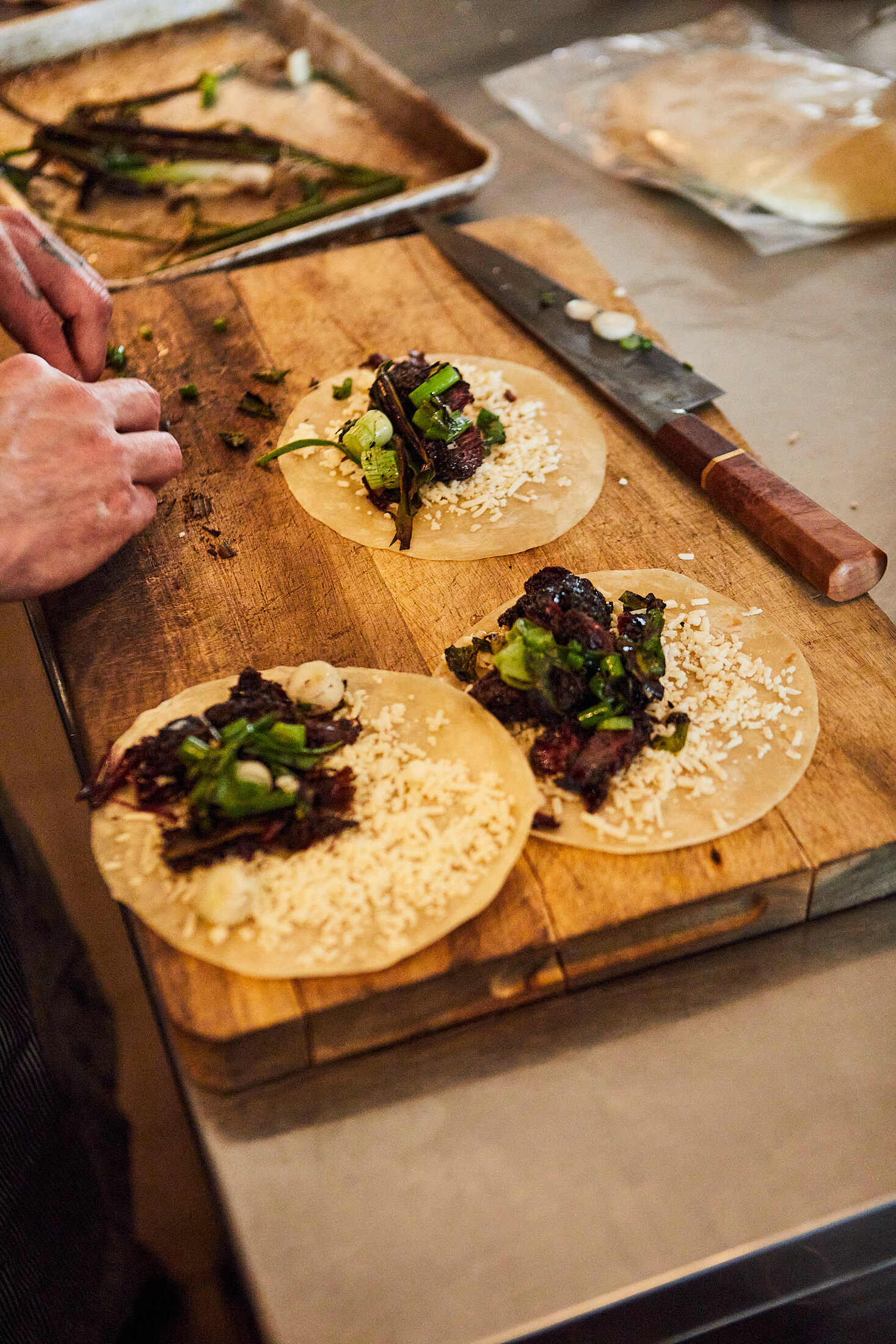On the farm: HEMME BROTHERS CREAMERY
A SERIES ABOUT OUR RELATIONSHIP WITH FARMERS, RANCHERS, FOOD PRODUCERS & MAKERS.
THE MAKER: Hemme Brothers Creamery
LOCATION: Sweet Springs Missouri
INGREDIENTS: Quark, Cheese Curds, Fresh Mozzarella, Aged Chedddar
At 8:30 a.m. on a bright and chilly early spring day, a small caravan of cars rolls up to Hemme Brothers Creamery. It’s a respectable hour
to arrive given the drive from Kansas City, but David Hemme can’t resist teasing Chef Vaughn Good and the Fox and Pearl staff.
“You missed the day’s first milking!” says the farm’s 63-year-old patriarch.
The 180-acre family dairy and farmstead cheesemaking operation located 80 miles east of Kansas City is home to a herd of 150 Holsteins, the same familiar black-and-white-spotted cow grazing in a field of emerald-green grass imprinted on the side of milk cartons.
While the farm scene looks bucolic and care-free, dairy cows require milking twice per day, usually starting around 4 a.m., and again at 4 p.m., and it’s a schedule that repeats seven days a week, 365 days a year. The rigid schedule might seem worthwhile if commodity milk prices hadn’t fluctuated wildly based on global market factors, leaving the price paid to a farmer below the cost of production.
“You have to understand what is going on in the world to understand what to do to adapt,” David says. “We were giving away the milk…and bleeding red ink. We realized that it’s our story that will sell. If you have a nice product, people are willing to pay extra for it, and that is what allows us to be profitable.”
““All my sons have college degrees, but they wanted to come back to work on the farm,””
Five years ago, the Hemme family decided to use their milk to make value-added farmstead cheeses, defined as a cheese made on the farm where the milk originates.
A large family photo hanging in the creamery’s foyer shot outdoors shows David and his wife, their four sons and daughter plus grandkids sitting or standing near bales of hay.
The sons are involved in every process on the farm. Nathan makes the cheese. Michael watches over the herd. Aaron manages nutrition for the herd. Jon takes care of the row crops and the heifers. David handles the marketing and distribution triangle from Leavenworth, Kan., to Springfield and St. Louis, Mo.
“All my sons have college degrees, but they wanted to come back to work on the farm,” David says.
The Hemme product lineup includes an American Cheese Society award-winning fresh quark, a German-style cream cheese with the tang of yogurt, as well as fresh mozzarella and curds flavored with a variety of seasonings ranging from ranch to sriracha. Aged cheeses include Brother’s Keeper aged cheddar and an applewood-smoked cheddar rubbed with Kansas City’s Plowboys Barbeque’s award-winning Yardbird Rub.
An observation window allows visitors to peer into a clean room with a red floor and 16-foot high ceilings. Dressed in aprons, a hairnet or cap and knee-high rubber boots, Nathan and an employee lean over a stainless-steel vat with a pitchfork, churning the whey out of a batch of fresh cheese curds that looks like sponge-y tofu. The protein-rich whey is used to feed the farm’s heritage hogs.
Chef Vaughn describes the prized cheddar as both sharp and acidic: “It melts in your mouth, and because it’s acidic it gets you salivating.”
As the Fox and Pearl crew steps outside the creamery building, Edelweiss, a mud-spattered white Great Pyrenees, strides out of a nearby barn to greet them. Once inside the barn, the herd eyes the intruders warily as they chew on corn silage.
Holstein cows weigh an average of 1,300 pounds. They are shy and easily stressed, but under the right conditions they will produce enough milk for 3 tons of cheddar cheese over a 5-year lifespan.
“Everyone wants cows to be out on green grass, and it makes a very pretty picture. And we do graze them on grass when we can, but what do they eat when there’s a drought?” David says.
Cheese curds are a common staple in upper Midwestern states, where they are sometimes referred to as “squeaky cheese” due to the sound the curds make against the teeth. The curds are typically eaten as a snack, or star in regional dishes like poutine, a famous Quebec, Canada, favorite of French fries topped with cheese curds and gravy.
The original idea was to create cheddar.
“The hardest thing you can do is make aged cheddar because of the time involved. Aged cheddar was going to be our cash cow. The problem was people like cheese curds,” David says as his eyebrows raise and his shoulders shrug.
Cheese curds can be made in a day while aged cheddar require 12 to 14 months. In the aging room, rectangular pine boxes containing 40-pound blocks of cheddar are stacked 16 high to create what David refers to as a “stairway to heaven.”
“You’re looking at $200,000 worth of cheese,” he says.
What the cows eat is an important component for high-quality milk production: “I can 100% tell the difference. It has a better texture and better flavor notes, which I think comes from what the cows are eating and how they are cared for.”
While farmstead cheese has undeniable star power on a charcuterie board, Chef Vaughn prefers to think of cheese as an ingredient that is part of the chorus.
Potted cheese — an English cheese spread similar to pimento cheese minus the Southern pimentos — is a staple at Fox and Pearl. It is served with craggy, textured artisanal bread from 1900 Barker in Lawrence. The potted cheese complements a host of charcuterie items, such as house-made sausage, rillettes and patê.
The freshly shredded cheese is served as fried crisps to adorn salads, is added to smoked pesto or provides the edible glue for smoked beef cheek quesadillas with Crum’s Heirlooms spring onions that Chef Vaughn grills on the open hearth. The Caramelo tortillas, produced in Lawrence, are folded in half, and placed on a griddle to toast until speckled with char. The dish is finished with purple chive blossoms and served with a side of “ash salsa” of roasted poblano peppers.
Chef Vaughn is also a fan of Hemme Brothers fresh cheese curds, which he often marinates or flavors with his own spice combinations. An example includes a capicola, pork rillette and chicken liver pate with whole grain mustard and Hemme Brothers cheese curds.
“You don’t see a lot of curds on menus, so I think it’s kind of unique,” he says. “I also like the old school-ness of it, and that it’s something that has been forgotten a little bit and has come back.”
The Dish: Smoked Beef Cheek in Tallow Confit with Hemme Brothers Cheddar, Crum’s Heirlooms Grilled Spring Onions, Caramelo Pork-Fat Tortillas

















